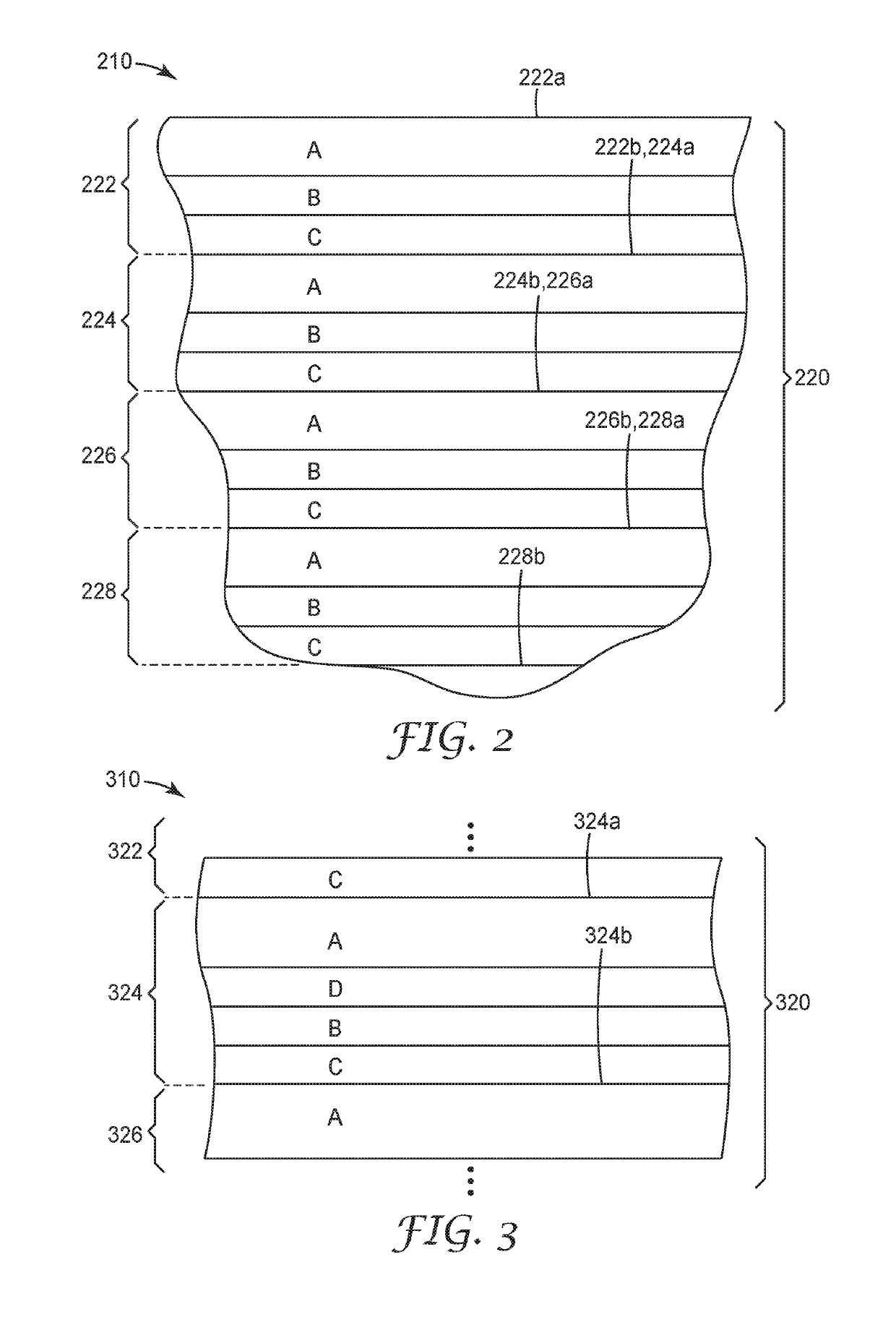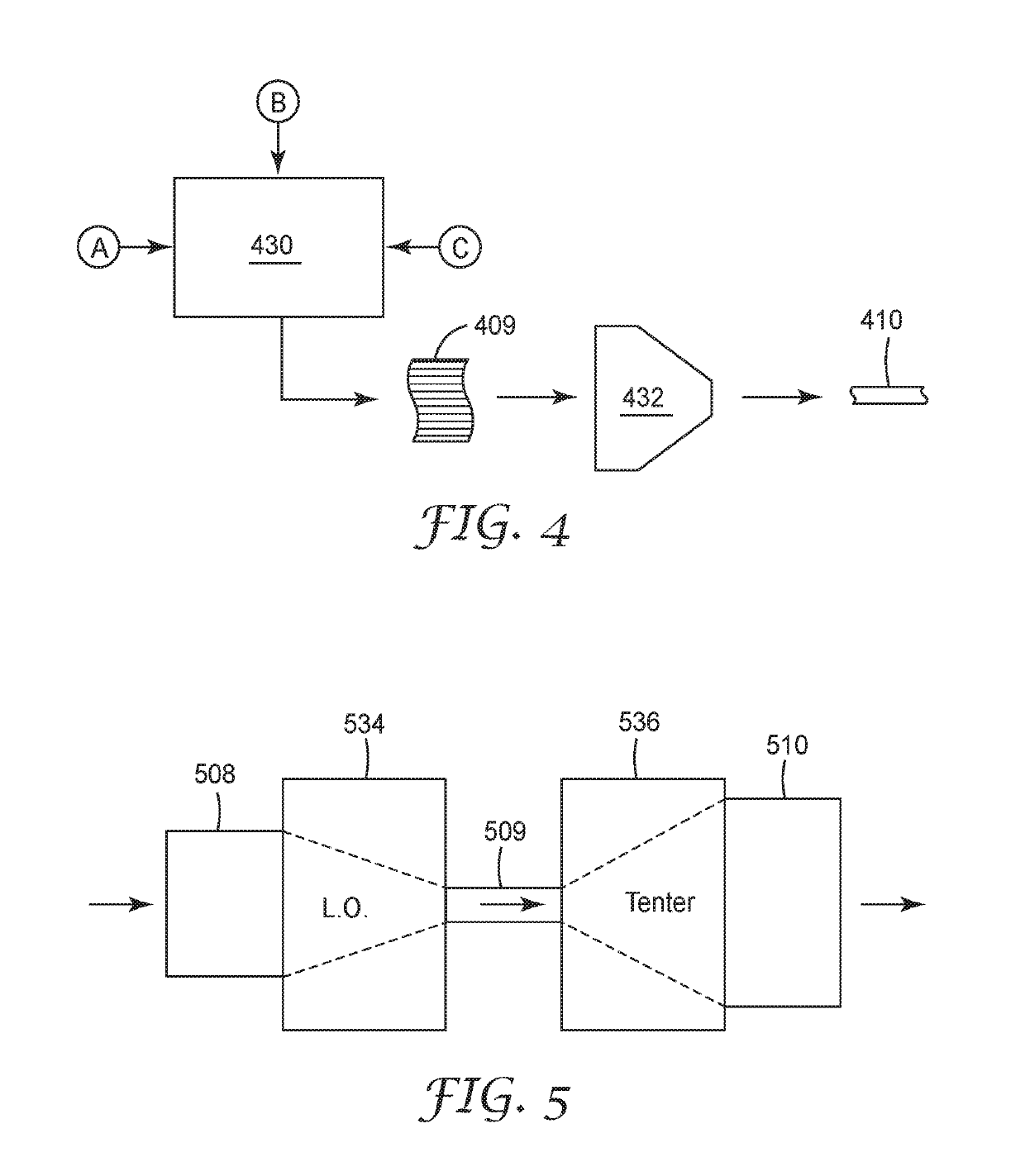Coextruded polymer film configured for successive irreversible delamination
a polymer film and coextrusion technology, applied in the field of polymer films, can solve the problems of design, introduce inherent limitations in the types of films, and concomitant upper limits on the number of such sheets, and achieve the effect of thin and flexibl
- Summary
- Abstract
- Description
- Claims
- Application Information
AI Technical Summary
Benefits of technology
Problems solved by technology
Method used
Image
Examples
example 1
[0061]In Example 1, the following polymer compositions and extruder flow rates were used:[0062]polymer composition A: PET resin of intrinsic viscosity 0.60, at a flow rate of 15 pounds / hr (6.8 kg / hr);[0063]polymer composition B: PETg copolyester (product code EASTAR GN071 from Eastman Chemical Co., Kingsport, Tenn., USA), at a flow rate of 5 pounds / hr (2.3 kg / hr);[0064]polymer composition C: a blend of a polypropylene / polyethylene copolymer (product code PP8650 from Total Petrochemicals, Inc., Houston, Tex., USA), at 70 wt % (flow rate of 7 pounds / hr (3.2 kg / hr)), and a styrene ethylene propylene styrene (SEPS) block copolymer resin (product code KRATON G1657 from Kraton Performance Polymers Inc., Houston, Tex,, USA), at 30 wt % (flow rate of 3 pounds / hr (1.4 kg / hr)); and[0065]polymer composition D: same as polymer composition A, but at a flow rate of 10 pounds / hr (4.5 kg / hr).
[0066]These materials were used to make a cast web film as described above. The cast web film had a thicknes...
example 2
[0072]In Example 2, the following polymer compositions and extruder flow rates were used:[0073]polymer composition A: PET resin of intrinsic viscosity 0.60, at a flow rate of 10 pounds / hr (4.5 kg / hr);[0074]polymer composition B: a blend of a polypropylene / polyethylene copolymer (product code PP8650 from Total Petrochemicals, Inc., Houston, Tex., USA), at 70 wt % (flow rate of 7 pounds / hr (3.2 kg / hr)), and a styrene ethylene propylene styrene (SEPS) block copolymer resin (product code KRATON G1645 from Kraton Performance Polymers Inc., Houston, Tex., USA), at 30 wt % (flow rate of 3 pounds / hr (1.4 kg / hr));[0075]polymer composition C: a blend of a polypropylene / polyethylene copolymer (product code PP8650 from Total Petrochemicals, Inc., Houston, Tex., USA), at 90 wt % (flow rate of 9 pounds / hr (4.1 kg / hr)), and a styrene ethylene propylene styrene (SEPS) block copolymer resin (product code KRATON G1645 from Kraton Performance Polymers Inc., Houston, Tex., USA), at 10 wt % (flow rate o...
example 3
[0083]In Example 3, the following polymer compositions and extruder flow rates were used:[0084]polymer composition A: a methylmethacrylate / ethylacrylate (MMA / EA) co-polymethylmethacrylate (coPMMA) (product code ATOGLAS 510A from Arkema Inc., King of Prussia, Pa., USA), at a flow rate of 5 pounds / hr 2.3 kg / hr);[0085]polymer composition B: a styrene ethylene propylene styrene (SEPS) block copolymer resin (product code KRATON G1645 from Kraton Performance Polymers Inc., Houston, Tex., USA), at a flow rate of 10 pounds / hr (4.5 kg / hr);[0086]polymer composition C: a blend of a polypropylene / polyethylene copolymer (product code PP8650 from Total Petrochemicals, Inc., Houston, Tex., USA), at 80 wt % (flow rate of 8 pounds / hr (3.6 kg / hr)), and a styrene ethylene propylene styrene (SEPS) block copolymer resin (product code KRATON G1645 from Kraton Performance Polymers Inc., Houston, Tex., USA), at 20 wt % (flow rate of 2 pounds / hr (0.91 kg / hr)); and[0087]polymer composition D: a polypropylene...
PUM
| Property | Measurement | Unit |
|---|---|---|
| thickness | aaaaa | aaaaa |
| thickness | aaaaa | aaaaa |
| thickness | aaaaa | aaaaa |
Abstract
Description
Claims
Application Information
 Login to View More
Login to View More - R&D
- Intellectual Property
- Life Sciences
- Materials
- Tech Scout
- Unparalleled Data Quality
- Higher Quality Content
- 60% Fewer Hallucinations
Browse by: Latest US Patents, China's latest patents, Technical Efficacy Thesaurus, Application Domain, Technology Topic, Popular Technical Reports.
© 2025 PatSnap. All rights reserved.Legal|Privacy policy|Modern Slavery Act Transparency Statement|Sitemap|About US| Contact US: help@patsnap.com



